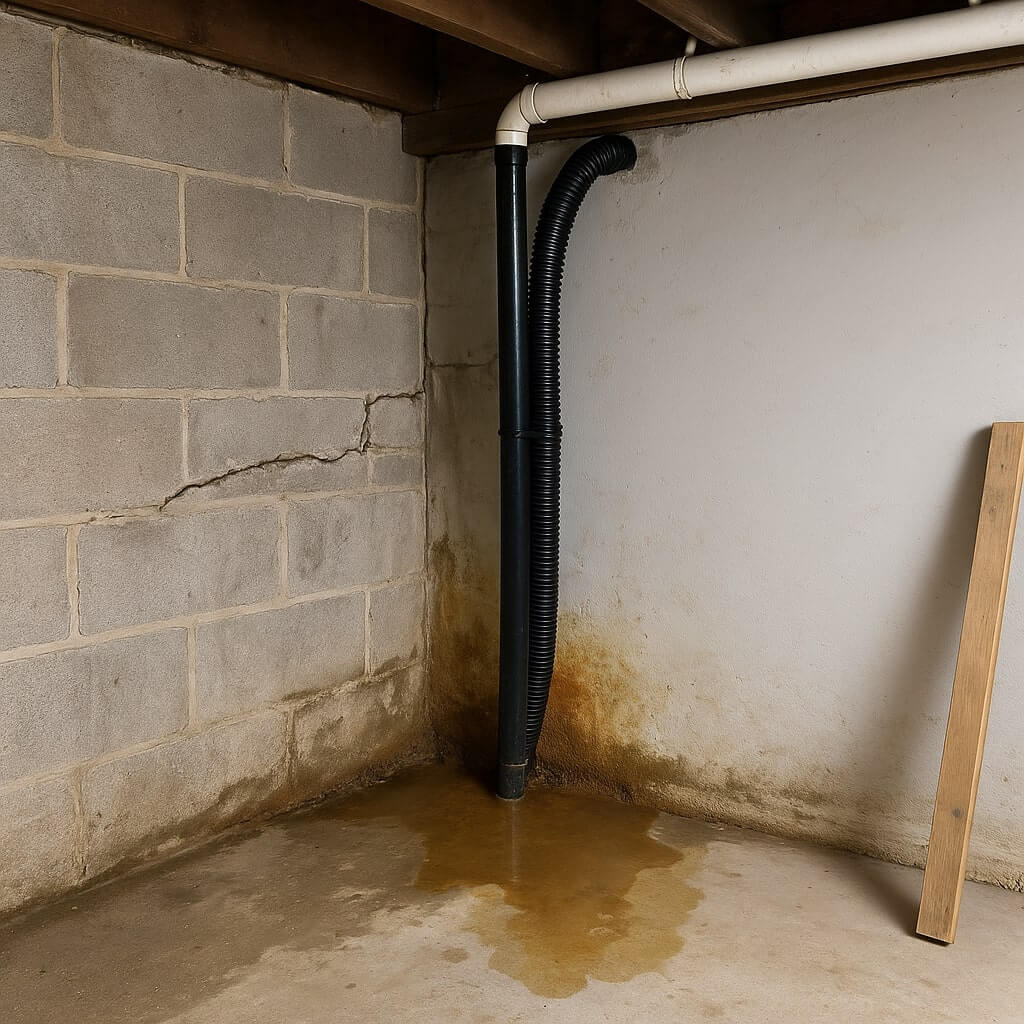When it comes to basement waterproofing in Cape Cod, you can’t afford to overlook common mistakes that could jeopardize your home. Ignoring drainage systems or neglecting wall cracks may seem minor, but they can lead to significant issues down the line. Understanding these pitfalls is essential for effective prevention. Let’s explore how to protect your investment and guarantee your basement remains dry and structurally sound.
Key Takeaways
- Neglecting regular inspections of drainage systems can lead to costly flooding and structural damage in basements.
- Skipping proper surface grading creates negative slopes, increasing the risk of water pooling around the foundation.
- Overlooking wall and floor cracks, especially horizontal ones, can cause serious moisture intrusion and foundation issues.
- Failing to control humidity with dehumidifiers can result in mold growth and poor indoor air quality in basements.
- Attempting DIY waterproofing without professional guidance may lead to ineffective solutions and greater long-term expenses.
Ignoring Water Drainage Systems
When you neglect water drainage systems, you’re setting the stage for potential basement flooding and structural damage.
Effective drainage system installation is essential for proper water flow management. Without it, water can pool around your foundation, leading to increased hydrostatic pressure. This pressure can cause leaks and compromise your home’s integrity.
Regular inspection and maintenance of these systems guarantee they’re functioning at their best, directing water away from your basement. By prioritizing drainage, you’re not just preventing immediate issues but also safeguarding your property’s long-term value.
Don’t underestimate the importance of a well-designed drainage system; it’s your first line of defense against water intrusion.
Neglecting Wall and Floor Cracks
If you overlook wall and floor cracks, you risk serious moisture intrusion and structural deterioration in your basement. Regular crack inspection is essential to maintain your foundation integrity and prevent costly repairs. Here’s a quick reference to understand the types of cracks and their potential implications:
| Crack Type | Implication |
|---|---|
| Hairline Cracks | Minor, often cosmetic |
| Vertical Cracks | Possible foundation settlement |
| Horizontal Cracks | Severe pressure, requires urgent attention |
| Diagonal Cracks | Structural issues, monitor closely |
| Shrinkage Cracks | Common, usually harmless |
Addressing cracks promptly can save you from extensive damage later.
Skipping Proper Surface Grading
Proper surface grading is essential for effective basement waterproofing, as it directs water away from your foundation. If you skip this critical step, you risk creating a negative surface slope that allows water to pool around your home.
This can lead to increased hydrostatic pressure and potential flooding in your basement. Ascertain your yard has a proper surface slope, ideally sloping away at least six inches over the first ten feet.
Implementing effective drainage solutions, like French drains or swales, can further enhance water management. Don’t underestimate the importance of proper grading; it’s a foundational element of your waterproofing strategy.
Using Inadequate Waterproofing Products
Choosing inadequate waterproofing products can undermine your basement’s protection against water intrusion.
If you opt for poor material selection, you risk using sealants that don’t bond effectively or withstand the pressure of water. Inadequate sealants may crack or peel over time, leading to leaks and costly repairs.
Always prioritize high-quality materials designed specifically for waterproofing applications. Research product specifications and performance ratings to guarantee they meet your basement’s specific needs.
Failing to Address Humidity Levels
When waterproofing your basement, you can’t overlook humidity levels, as they can greatly impact your space.
Identifying the sources of humidity, using dehumidifiers effectively, and monitoring indoor air quality are essential steps in maintaining a dry environment.
Addressing these factors helps prevent mold growth and structural damage, ensuring your basement remains a safe and functional area.
Understanding Humidity Sources
Although you might focus on visible water intrusion, failing to address humidity levels in your basement can lead to significant long-term issues. Understanding the sources of humidity is essential for effective humidity control. Common sources include:
| Source | Description |
|---|---|
| Ground Moisture | Water vapor from the soil beneath |
| Poor Ventilation | Inadequate airflow increases humidity |
| Plumbing Leaks | Hidden leaks can elevate moisture levels |
| Humid Outdoor Air | High humidity days can infiltrate basements |
Implementing proper moisture barriers and addressing these sources can effectively mitigate humidity-related problems, ensuring a healthier environment in your basement.
Using Dehumidifiers Effectively
Using dehumidifiers effectively can considerably reduce humidity levels in your basement, but many homeowners overlook key factors that maximize their performance.
Proper dehumidifier placement is essential; positioning it in the most humid areas guarantees optimal airflow and efficiency. Make sure that the unit is elevated slightly off the ground to prevent water damage and maintain airflow.
Additionally, regularly clean the filters to enhance humidity control and performance. Monitor the settings to maintain ideal indoor humidity levels, typically between 30-50%.
Neglecting these aspects can lead to inadequate moisture removal, ultimately compromising your basement’s integrity and increasing mold risks.
Monitoring Indoor Air Quality
Failing to monitor indoor air quality can lead to serious issues, especially when it comes to humidity levels in your basement. Elevated humidity can promote the growth of mold and increase indoor pollutants, negatively impacting your health.
To prevent this, guarantee proper air circulation by using fans and opening vents when possible. Regularly check humidity levels with a hygrometer, aiming to maintain them between 30-50%.
Additionally, consider integrating a dehumidifier to manage excess moisture effectively. By actively monitoring and addressing humidity, you create a healthier living environment and protect your basement from potential water damage.
Overlooking Ventilation Needs
When you focus solely on waterproofing your basement, you might neglect the crucial aspect of ventilation, which can lead to lingering moisture problems and mold growth.
Proper air circulation is necessary to maintaining a healthy basement environment. Without effective ventilation systems, trapped air can become stale, increasing humidity levels and creating an ideal breeding ground for mold.
To prevent these issues, verify your basement has adequate ventilation by installing exhaust fans, air vents, or dehumidifiers.
Regularly check and maintain these systems to optimize air circulation, safeguarding your investment and enhancing indoor air quality for your home.
Dismissing Professional Help
While it may be tempting to tackle basement waterproofing as a DIY project, dismissing professional help can lead to costly mistakes and inadequate solutions.
Engaging in a professional consultation guarantees you receive an expert assessment of your basement’s unique needs. Professionals can identify underlying issues, such as structural damage or improper drainage, which you might overlook.
Their expertise allows for tailored waterproofing strategies that effectively mitigate water intrusion. By relying on experienced specialists, you not only save time and money but also enhance your home’s integrity.
Don’t underestimate the value of professional insight in safeguarding your basement against future water damage.
Underestimating Regular Maintenance
Neglecting regular maintenance can greatly compromise your basement waterproofing efforts. You shouldn’t underestimate the importance of routine care.
Regular inspections allow you to identify potential issues before they escalate, ensuring your waterproofing system functions effectively. Implementing preventative measures, like cleaning gutters and checking for cracks, can considerably reduce the risk of water intrusion.
Don’t wait for signs of moisture or damage to take action; proactive maintenance is key to safeguarding your investment. By prioritizing these tasks, you not only extend the life of your waterproofing solution but also maintain a dry, healthy basement environment for years to come.
Conclusion
To effectively protect your basement in Cape Cod, avoid these common waterproofing mistakes. Prioritize proper drainage systems, regularly inspect for cracks, and guarantee correct surface grading. Don’t skimp on quality waterproofing products, address humidity levels, and maintain adequate ventilation. Seeking professional help can uncover underlying issues, while routine maintenance guarantees long-term effectiveness. By being proactive and informed, you can safeguard your home from moisture-related damage and preserve its structural integrity.




